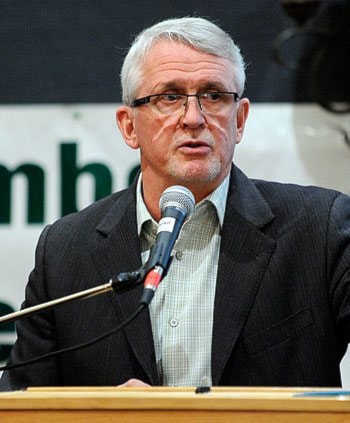More than six months ago, Yukon Energy got some bad news about its Gladstone diversion project.
But utility president David Morrison kept it under wraps.
At a public meeting less than two weeks ago and during a chamber of commerce luncheon a few months ago, David Morrison talked up Gladstone as a viable option to feed the Yukon’s energy demand.
(Within five years, Yukon Energy will need roughly 200 more gigawatt hours of power - that’s more than half of the 375 gigawatt hours the grid is currently capable of supplying.)
The Gladstone project involves diverting water from a chain of lakes roughly 40 kilometres west of Destruction Bay into the Sekulmun-Aishihik Lake system, to produce up to 18 gigawatt hours of electricity annually using the turbines at the Aishihik hydro facility.
The science is finished, Morrison told business leaders during the chamber luncheon on January 18.
But a report obtained by the Yukon NDP says otherwise.
The federal Fisheries and Oceans report - dated September 30 - puts the kibosh on Gladstone.
“Due to the significance of the potential impacts to fish and fish habitat, DFO is not prepared to consider a Fisheries Act authorization for your proposal at this time.”
And it gives more detail.
“Potential impacts include ... disease transfer, transfer of organisms and parasites, changes in water quality (and) changes in temperature….
“Also, flooding the Gladstone chain lakes would reduce creek flow by 60 per cent, resulting in “harmful alteration, disruption or destruction of fish habitat.”
And fish aren’t the only issue.
Damming Gladstone would alter water flow across an international boundary, between the Yukon and Alaska.
“Several Canadian statutes govern the protection and establish policy for the bulk transfer of waters from international transboundary waters,” says the federal report.
“It is advised Yukon Energy seek further information on these statutes and possible limitations they may impose on the proposal.”
Morrison never mentioned the report, or the concerns it raises, during the luncheon.
But someone in the audience asked: Wouldn’t it be the first time a body of water’s flow has been reversed across an international boundary?
That is an issue, said Morrison.
He said no more about the issue.
Calls to Morrison were not returned by press time.
But, asked about the federal report, Yukon Energy spokesperson Janet Patterson responded with an email.
“Our understanding from DFO is that the letter that they sent to us is a standard letter that they send to everyone involved in potential projects that would involve diverting water from one watershed to another,” she wrote.
But Fisheries and Oceans visited the Gladstone site.
And its report details potential impacts to Gladstone and Isaac creeks, the Yukon River Watershed and the Alsek River Watershed.
Yukon Energy’s website states “that the impact to lake levels would be slight.”
But Fisheries and Oceans reports levels in the three Isaac Creek lakes could drop by as much as 5.6 metres.
Fisheries and Oceans also has grave concerns about the transfer of parasites and pathogens.
“The results of our studies to date have shown there are no significant problems with parasites in one watershed not being in the other watershed,” wrote Patterson.
“In other words, the same parasites were in both systems.”
But the Fisheries and Oceans report stresses:
“From a fishery perspective, the transfer or pathogens and parasites from one watershed to another could have irreversible impacts on downstream fisheries.”
Yukon Energy hired “the foremost fish experts in North America (BC-based Centre for Coastal Health) to develop and oversee the fish pathogen study program for Gladstone,” wrote Patterson.
But Gladstone is “merely just a concept,” she wrote. “There is no project. There is no project proposal.”
Still Yukon Energy is throwing money at Outside firms to study its Gladstone “concept.”
Yukon Energy is also working with the Kluane First Nation and the Champagne/Aishihik First Nations on Gladstone, wrote Patterson.
“Yukon Energy’s understanding is that the Champagne/Aishihik First Nations and the Kluane First Nation governments have decided not to make any final conclusions about the merits of the concept until there’s enough information to make an informed decision,” wrote Patterson.
“This is the process Yukon Energy has also asked DFO to consider.”
But Fisheries And Oceans is clear.
“The plan should be revised to eliminate interbasin water transfer and reduce negative effects to fish habitat.”
But the whole idea behind the Gladstone diversion is moving water from one group of lakes to another.
The project would “divert water from the Gladstone lakes into the Sekulmun-Aishihik Lake system,” says Yukon Energy’s website.
“This would be done by building a structure that would move water from the upper reaches of Gladstone Creek into Isaac Creek, which flows into Sekulmun Lake and then into Aishihik Lake.”
Gladstone would double the nine gigawatt hours Yukon Energy could generate by raising Marsh Lake’s water level.
It’s on par with the 18 gigawatt hours that could be generated by holding Atlin Lake at its seasonal high for months at a time - something Yukon Energy is proposing and the BC community is opposing.
(Atlin residents have concerns that raising lake levels would impact fish, ice, water temperature, water quality, shore birds and habitat.)
Yukon Energy’s other power proposals include burning garbage, setting up wind turbines and cutting demand by educating Yukoners.
Next week, Yukon Energy is hosting a charette to discuss power needs in the territory.
Running March 7 to 9, the meeting’s evening sessions are open to the public, from 7 to 9 p.m.
The event is at Mount McIntyre rec centre.
For more information go to: www.yukonenergy.ca/letstalk/energy_charrette/.
Contact Genesee Keevil at
gkeevil@yukon-news.com
